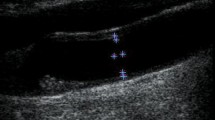Summary
In exposed common carotid arteries of 15 patients (36–74 years) undergoing neck surgery, the intra-arterial pressure (P) was recorded by means of a catheter-tip manometer and, at the same site, the external diameter (D) by means of a contactfree photoelectric device. On the average, the pulsatile diameter changes were 5.6% of the end-diastolic diameter at pulse pressures of about 50 mm Hg. Due to viscoelasticity, the P-D diagrams exhibited hysteresis loops. Using the criterion of loop elimination, an iterative procedure was applied which permitted, by the use of an appropriate computer program, the separation of the purely elastic and the purely viscous components of the P-D relationships. In all cases, the purely elastic P-D curves markedly deviated from linearity. The tangential elastic modulus (Et) and the pulse wave velocity (c) calculated from these curves were normalized by dividing these quantities by the respective end-diastolic values and plotted against the normalized external diameters. During each pulse cycle, Et increased, with increasing diameter, by a factor between 1.2 and 3.5, while c increased by a factor between 1.1 and 1.9 with reference to the respective end-diastolic values.
Zusammenfassung
An 15 Patienten im Alter zwischen 36 und 74 Jahren, bei denen während einer Halsoperation die A.carotis communis freigelegt war, wurden simultan der intraarterielle Karotisdruck (P) mit einem Katheterspitzenmanometer und an derselben Stelle der arterielle Außendurchmesser (D) mit einem berührungsfreien photoelektrischen Verfahren registriert. Die relativen Durchmesseränderungen, bezogen auf den enddiastolischen Außendurchmesser, betrugen im Mittel 5,6% bei Druckamplituden von etwa 50 mm Hg. Die durch die Viskoelastizität der Arterienwand bedingten Hystereseschleifen der pulsatorischen P-D-Beziehungen wurden mit Hilfe eines iterativen Verfahrens unter Verwendung eines Digitalrechners eliminiert, wodurch eine Trennung der rein elastischen und der rein viskösen Komponenten der P-D-Beziehung ermöglicht wurde. Aus den rein elastischen P-D-Beziehungen wurden der tangentiale Elastizitätsmodul und die Pulswellengeschwindigkeit als Funktionen des Außendurchmessers berechnet und in normierter Form, d. h. bezogen auf den jeweiligen enddiastolischen Wert, dargestellt. Mit wachsendem Durchmesser stieg der Elastizitätsmodul während jedes Pulszyklus auf das 1,2- bis 3,5fache des enddiastolischen Wertes an. Entsprechend nahm die Pulswellengeschwindigkeit auf das 1,1- bis 1,9fache des enddiastolischen Wertes zu.
Similar content being viewed by others
References
Arndt, J. O.: Über die Mechanik der intakten A.carotis communis des Menschen unter verschiedenen Kreislaufbedingungen. Arch. Kreislaufforschg.59, 153–197 (1969).
Dobrin, P. B.: Mechanical properties of arteries. Physiol. Rev.58, 397–447 (1978).
Gow, B. S., M. G. Taylor: Measurement of viscoelastic properties of arteries in the living dog. Circ. Res.23, 111–122 (1968).
Greenfield, J. C., G. T. Tindall, M. L. Dillon, M. S. Mahaley: Mechanics of the human common carotid artery in vivo. Circ. Res.15, 240–246 (1964).
Kober, G., J. O. Arndt: Die Druck-Durchmesser-Beziehung der A.carotis communis des wachen Menschen. Pflügers Arch.314, 27–39 (1970).
Mozersky, D. J., D. S. Sumner, D. E. Hokanson, D. E. Strandness: Transcutaneous measurement of the elastic properties of the human femoral artery. Circulation46, 948–955 (1972).
Ungern-Sternberg, A. v., W. Traxel, C. J. Schuster: Transkutane Messung altersbedingter Veränderungen der Gefäßelastizität der Arteria carotis communis des Menschen. Z. Kardiol.64, 879–888 (1975).
Wetterer, E., R. D. Bauer, R. Busse: New ways of determining the propagation coefficient and the visco-elastic behaviour of arteries in situ. In:R. D. Bauer, R. Busse (Eds.), The Arterial System-Dynamics, Control Theory and Regulation. pp. 35–47. (Berlin-Heidelberg-New York 1978).
Wetterer, E., R. Busse, R. D. Bauer, A. Schabert, Y. Summa: Photoelectric device for contact-free recording of the diameters of exposed arteries in situ. Pflügers Arch.368, 149–152 (1977).
Wetterer, E., Th. Kenner: Grundlagen der Dynamik des Arterienpulses (Berlin-Heidelberg-New York 1968).
Author information
Authors and Affiliations
Additional information
With 4 figures and 2 tables
Preliminary reports were given at the 49th and the 50th Congress of the German Physiological Society, Göttingen, March and October 1978.
Rights and permissions
About this article
Cite this article
Busse, R., Bauer, R.D., Schabert, A. et al. The mechanical properties of exposed human common carotid arteries in vivo. Basic Res Cardiol 74, 545–554 (1979). https://doi.org/10.1007/BF01907647
Received:
Issue Date:
DOI: https://doi.org/10.1007/BF01907647




